|
Lava tubes are a type of cave found all over the world. They are the
second highest occurring cave in the world and can vary from tens of
feet to several miles long.
Lava tubes form when molten rock oozes out of the Earth, as in a
volcanic eruption, and slides down the side. The outer surface of the
lava cools and hardensforming a tube. Lava continues to flow through the
tube until the source of the lava ceases.
|
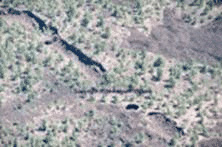
Ariel view of a lava tube. Photo by Kenneth Ingham.
|
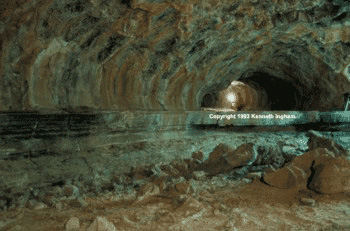
Inside of an extinct lava tube.
|
Lava tubes can be active or extinct.
Active lava tubes continue to seep lava, or molten rock, from the
source.
Extinct lava tubes have no active flow and they have cooled and hardened
leaving a cave-like channel.
|
|
Lava tubes are home to some interesting features. One such feature is
"bacterial mats", or lava wall slime, that grows in both the twilight
zones and the dark zones of the cave. However, even though they grow
abundantly, not much is known about these communities.
So, the Slime Team went to El Malpais National Monument in New Mexico
U.S.A. to investigate the bacterial mats of Four Windows Cave.
Bacterial mats cover about 25% to 75% of the walls of the first 500 feet
of Four Windows Cave.
|
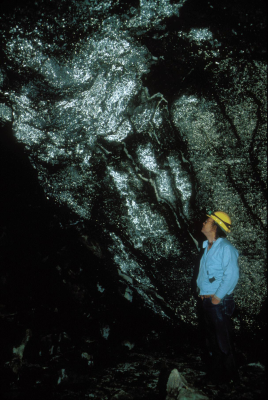
Bacterial mats in Four Windows Cave. The walls appear
silver when a light shines on the mats. Photo by Kenneth Ingham.
|
|
The bacteria covering 25% of the walls show large areas of wall through
empty spaces in the mats.
While areas that cover 75% of the walls showed very small patches of
wall though the mats.
These bacterial mats were thought to be made of Actinomycetes, bacteria
that break down complex organic matter.
Actinomycetes are known to thrive in environments where food is meager
and living conditions extreme; they are commonly found living in caves.
|
Missing photo
Bacterial mats in Four Windows Cave. The walls appear silver when
a light shines on the mats. Photo by
Kenneth Ingham.
|
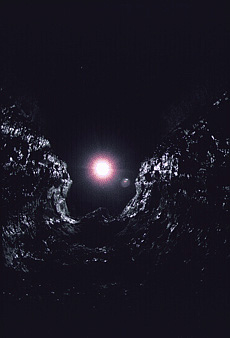
Lights shining behind bacterial mats show the silver
shine of the mats.
|
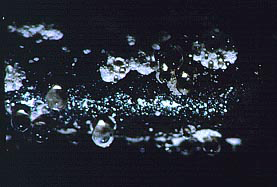
Water dripping into the cave. This is a possible
source of food for the bacteria.
|
|
The bacteria gain their energy from organic matter that seeps in the
cave in water from the surface. Microbes on the surface break down
organic matters, such as leaves. The compounds then mix with water on
the surface, which then drips into the cave.
|
|
Actinomycetes also come in different colors. They can be pink, silver,
white, yellow, or gold.
Different pigments in the bacteria produce the colors. Scientists do not
known why or how the bacteria make these pigments. These colors are seen
all over the world; caves in the Azores have gorgeous gold-pigmented
bacteria on the walls.
The Slime Team extracted DNA from the wall communities to determine what
types of bacteria were living in these communities. The DNA was
purified, the samples cloned, and later the sequences were compared to
the Ribosomal Database. The data showed that the bacteria from Four
Windows Cave was most closely related to Actinomycetes.
|
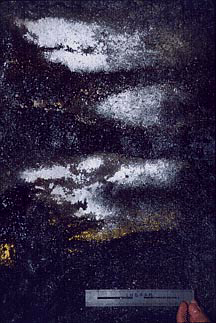
Example of a white and gold bacterial mat. Photo by
Kenneth Ingham.
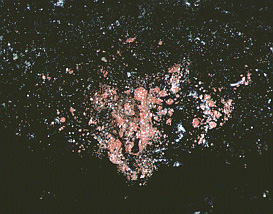
Example of pink bacterial mats. Photo by
Kenneth Ingham.
|
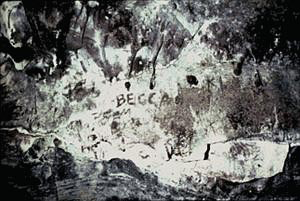
An unknowing visitor wrote their name in one of the
bacterial communities. Photo by
Kenneth Ingham.
|
The Slime Team then investigated the amount of adaptation the
Actinomycetes had gone through in order to live in the lava tubes.
In order to do this, they tested the capacity of the bacteria to endure
the effects of UV radiation (i.e. simulating sunlight). The results
showed that the bacteria from the lava tubes of Four Windows Cave were
much more sensitive to UV light than the bacterial microbes collected
from the surface. This indicates that the bacterial communities in Four
Windows may be relatively cave-adapted.
|







